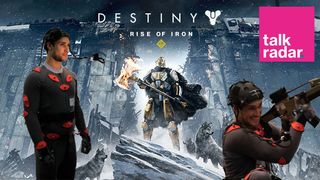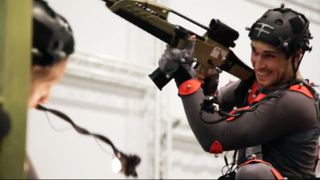World in motion: in conversation with the mo-cap artist behind Destiny's Lord Saladin
Finding out what life's like in a ball-covered suit

We may be entering the age where robots can do most jobs a human can do, but one thing they still struggle with is realistic movement. This means that in video games and films where digital characters appear, there is often a motion-capture performer behind the scenes to thank for the naturalistic movement.
Mo-cap has come to prominence recently with Andy Serkis’ now infamous work as Gollum on the Lord of the Rings trilogy, Andy Serkis’ work on the Planet of the Apes franchise, and Andy Ser… No, no, it’s more than just Andy Serkis.
You probably won’t even realise that most of the motion capture work you’ll see is motion capture. For this edition of TalkRadar we are talking to James Alexander-Taylor, a motion-capture performer who has worked on films including Christopher Nolan’s upcoming epic Dunkirk, and video-games such as Destiny, Call of Duty, and Just Cause.
James, how do you get the job of motion capture performer?
There’s no easy way to get the job. It’s a lot like any other acting role. But what they mainly look for is someone that’s got physical capability. And on top of that, has a skill-set that lends itself to video game worlds. I’ve got military and combat experience, which helps as a lot of video game stuff is very combatant oriented.
How do you make the transition from a military background to mo-cap?
I spent quite a long time within the Royal Marines, learning all sorts of combat experiences, from arctic, to jungle, to urban warfare, to weapons handling, to tactics, and resistance to interrogation training. All this kind of stuff that lends itself to what video game worlds are. So making the transition isn’t all that difficult.
Get the best Black Friday deals direct to your inbox, plus news, reviews, and more.
Sign up to be the first to know about unmissable Black Friday deals on top tech, plus get all your favorite TechRadar content.
All you’ve got to do is put the performance on top. And luckily having experience as an actor, you can add the performance into it. You already have the authenticity of the technical side there.
Are they trying to get a true-to-life version of that movement or is it a performative version of it?
It depends on the context of the piece. If you’re playing a character in a zombie apocalypse you’ve got to use a certain degree of imagination. But you can still have the performative side. You know, the terror, being frightened, even though you’re just in an empty space in a mo-cap suit. Putting on the performance really helps the animators to know what they need to take away.

When I turned up to the studio to shoot Call of Duty I had no idea what it was. And then they said ‘You’re doing Call of Duty with Guy Richie.’
What’s the thing that has forced you to stretch your imagination the most?
Situations that I’ve never been in. Fantasy. Playing seven foot, eight foot people. Carrying huge flaming axes. Fighting off aliens. Things like that. Playing Lord Saladin in Destiny, who’s about eight foot. Massive muscular guy, carrying huge heavy armour, wielding a big flaming axe.… You can’t really do that.
You have to make it really small, and really commit to it. Then the animators put that on top. As long as the foundation’s there, they can put everything else on top.
You can’t wear something that is heavy to approximate what that would feel like because you have to be wearing a mo-cap suit?
Exactly. So there are different kinds of suits, usually the mo-cap suits we use have to have line of sight for the cameras. When we’re shooting on location, we can use suits that use a signal just like Wi-Fi, so you can wear a costume on top but the data that you capture isn’t as accurate. So having line of sight, you’re going to get fantastic data.
'Line of sight' the stereotypical mo-cap suit with the little balls all over it?
Absolutely. They’re reflective markers that reflect the data back into the cameras.
A big privilege to be directed by @JohnDower @themocapvaults the other week. Such fun and fun times ahead! #grateful pic.twitter.com/FsEmD7lJCSJuly 5, 2016
What does it feel like putting on a ball covered suit for the first time?
It’s liberating really. You know, you're there in all your glory. The weirdest thing is that it’s all velcro, so if you sit on anything, you get up and everything’s stuck to you. Trying to go to the toilet in one is quite a, you know. We discovered there’s something called the mo-cap onesie, where you’re able to slip it off like a onesie. Most of the time you avoid going to the toilet for a whole shoot which can be difficult.
When you go in to the studio, do you always know what you’re working on?
No. And that, I find, is the most exciting part of it. For example, when I turned up to the studio to shoot Call of Duty I had no idea what it was. And then they said ‘You’re doing Call of Duty with Guy Richie,’ and they thrust an NDA (non disclosure agreement, basically a contract saying you won’t talk about the project) in your face, and that’s how it is. You get very limited details about what you’re actually going to be doing.
Sometimes if you’re lucky you’ll get a script the night before, but that’s very rare. And if you do get a script, they give it to you for a couple of minutes on the day and then take it back off you.

It also depends on what kind of mo-cap you’re doing. You could be doing full performance capture, which is your voice, your face, your body, everything. Whereas a lot of the stuff I do is just the physical side.
Then someone else does the voice?
Yeah, so we have pre-recorded audio played to us on a shoot and then we physicalize those lines that have been done by an actor in a studio. That can be tricky. Because you hear the audio clip, and you maybe get to hear it once more and then you go straight into shooting the scene an you’ve got to get those gestures, those intonations, that timing right as soon as they say action.
It’s a huge challenge, and that’s what I love about it. It’s not ‘turn up and rehearse this character for six weeks’, you jump from character to character to character in a day. Then that’s it. Job done. You see the game and you go ‘Oh right, that’s what I was doing. Brilliant.”
It’s liberating really. You know, you're there in all your glory. The weirdest thing is that it’s all velcro, so if you sit on anything, you get up and everything’s stuck to you.
If you turn up to a locomotion shoot, you could be playing maybe twelve characters, and they could all have generic moves, so you’ve just got to record one set of character moves and they can blend them all into the other characters.
Or you could have a much longer shoot where you’re doing three characters that all have individual moves. You’ll have a list of moves starting as basic as an ‘idle’ which is if the player is in control of you but you’re not moving. You’re just standing as a character.
Ollie Hollis-Leick who I work with a lot, he’s worked in motion capture for 14, going on 15 years. He played Agent 47 in Hitman, and he spent a long long time just working on his idle, just the way Agent 47 stands. Because it's very unique.

To make a game a real real experience, the player wants to be able to do anything and everything with that character, so you want to try and record moves that the player can be in control of. There’s all sorts of detail that can go into it, and obviously the bigger the franchise, the bigger the movement vocabulary the character can have.
What makes a good motion capture performer?
A good mo-cap actor will be able to go in and give consistent data, and be totally detailed and on the mark technically. Because it’s not cinematic, it’s a completely different way of approaching the work, which is why there’s only a number of mo-cap performers that get asked to do locomotion stuff. The bread and butter of motion capture is locomotion shoots on video games. It’s where it all started. Obviously it’s now gone on to bigger things but that's the core of what makes a good mo-cap actor.
Have you ever been able to look at characters in a game and identify yourself?
Yeah, you can. It’s quite difficult, because sometimes you don’t know where the character you’ve done is going to be placed. You’ll understand the scene and the context of what’s going on but sometimes you won’t know where your character is going to be put.
For example, doing Dunkirk, we were filming lots of soldiers on a ship. We had to do variations of different soldiers and what they’re experiencing on that deck of the ship as it’s being attacked. And because there’s thousands of them on the ship it’s difficult to pick out which ones were you, there’s so many variations. You do maybe 25/30 variations in 20 minutes and often you can’t remember what you’ve done.
That said, I showed a promo video of Destiny to my mum and she could tell that it was me moving as Lord Saladin. I don’t know if that’s a good thing or a bad thing.
What’s the weirdest or best direction you’ve ever been given?
I think they kind of go hand in hand. I remember there was an imaginary person lying on the floor and Guy Ritchie said to me "Just shoot him in the head or something. Gimme something." That was it. And I just thought. 'Yeah, that’s Guy Ritchie'.
What has been your best day at work?
I think my first ever shoot was my best day. Unbeknownst to me I was working with a big game developer on a big game franchise, playing a huge character, and I didn’t know the scale of what I was working on. I had a chance to go to (gaming convention) BGX and saw this 25 foot picture of Lord Saladin, and it blew my mind that I’d been a small part of creating that game.
Final question, what are you working on at the moment?
I’m not actually at liberty to say. It’s a big game franchise, filming in early June, not sure when it’s released but it’s pretty cool. Pretty cool.
If you want to contact Alexander-Taylor with any employment opportunities, he can be reached at: [email protected]
- Andrew London has always been fascinated by the amazing things that people do that shape the way we live our lives. In his regular TalkRadar column, he will be interviewing people from across the world of tech to discover what they do, and why they do it.
Andrew London is a writer at Velocity Partners. Prior to Velocity Partners, he was a staff writer at Future plc.
Most Popular

